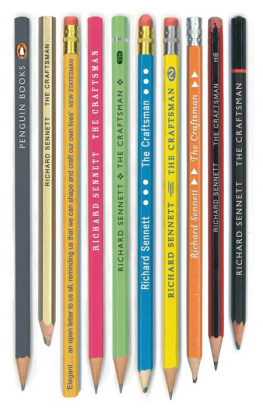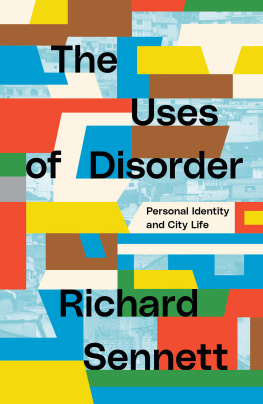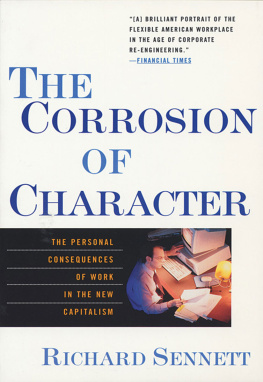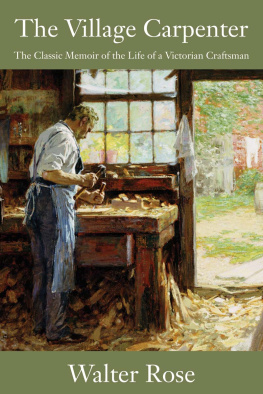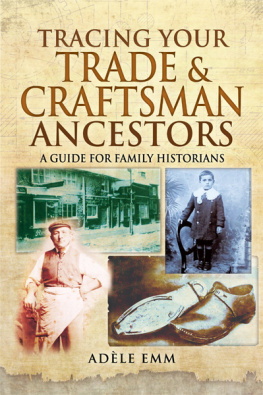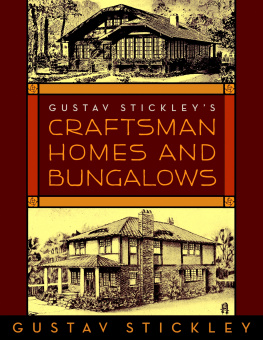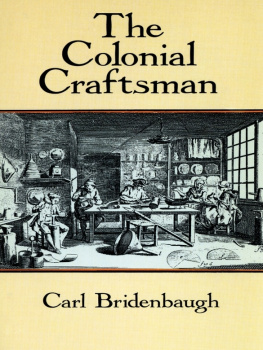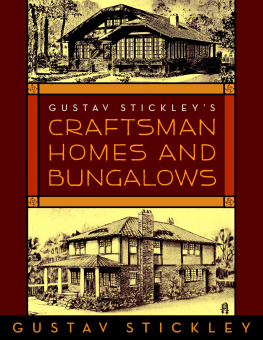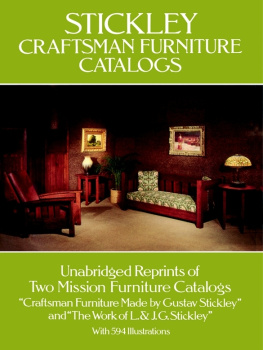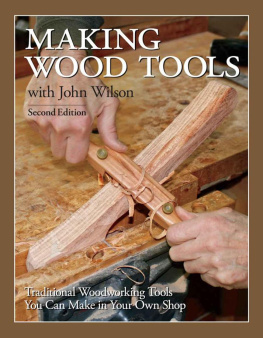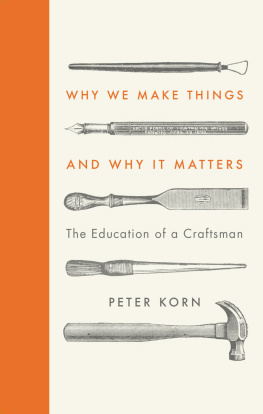T HE C RAFTSMAN
Richard Sennett
ALLEN LANE
an imprint of
PENGUIN BOOKS
ALLEN LANE
Published by the Penguin Group
Penguin Books Ltd, 80 Strand, London WC2R 0RL , England
Penguin Group (USA) Inc., 375 Hudson Street, New York, New York 10014, USA
Penguin Group (Canada), 90 Eglinton Avenue East, Suite 700, Toronto, Ontario, Canada M4P 2Y3
(a division of Pearson Penguin Canada Inc.)
Penguin Ireland, 25 St Stephens Green, Dublin 2, Ireland (a division of Penguin Books Ltd)
Penguin Group (Australia), 250 Camberwell Road, Camberwell, Victoria 3124, Australia
(a division of Pearson Australia Group Pty Ltd)
Penguin Books India Pvt Ltd, 11 Community Centre, Panchsheel Park, New Delhi 110 017, India
Penguin Group (NZ), 67 Apollo Drive, Rosedale, North Shore 0632, New Zealand
(a division of Pearson New Zealand Ltd)
Penguin Books (South Africa) (Pty) Ltd, 24 Sturdee Avenue, Rosebank, Johannesburg 2196, South Africa
Penguin Books Ltd, Registered Offices: 80 Strand, London WC2R 0RL , England
First published in the United States of America by Yale University Press 2008
First published in Great Britain by Allen Lane 2008
1
Copyright Richard Sennett, 2008
The moral right of the author has been asserted
All rights reserved Without limiting the rights under copyright reserved above, no part of this publication may be reproduced, stored in or introduced into a retrieval system, or transmitted, in any form or by any means (electronic, mechanical, photocopying, recording or otherwise), without the prior written permission of both the copyright owner and the above publisher of this book
978-0-14-191941-6
For Alan and Lindsay
travail, opium unique
Contents
Acknowledgments
I owe a peculiar debt to the philosopher Richard Foley. At a point when I was stuck in my work, he asked me, What is your guiding intuition? I replied on the spur of the moment, Making is thinking. Foley looked unconvinced. In the effort to persuade him, I thank my friends Joseph Rykwert, Craig Calhoun, Niall Hobhouse, and the late Clifford Geertz for advice and my editors Stuart Proffitt and John Kulka for comments on the manuscript.
In this project I learned from my students. In New York I particularly thank Monika Krause, Erin OConnor, Alton Phillips, and Aaron Panofsky; in London, Cassim Shepard and Matthew Gill. My research assistant, Elizabeth Rusbridger, proved a marvel, as has Laura Jones Dooley, the manuscript editor of this book.
Many of the case studies of craftsmanship concern musical practices. Ive drawn on my early experience as a working musician for these, as well as more recently on discussions about musical craft with three friends, Alan Rusbridger, Ian Bostridge, and Richard Goode.
Finally, Saskia Sassen, Hilary Koob-Sassen, and Rut Blees-Luxembourg made me the best gift a family can give a writer: they left me alone to think, smoke, and type.
Prologue: Man as His Own Maker
Pandoras Casket
Hannah Arendt and Robert Oppenheimer
Just after the Cuban Missile Crisis, the days in 1962 when the world was on the brink of atomic war, I ran into my teacher Hannah Arendt on the street. The missile crisis had shaken her, like everyone else, but it had also confirmed her deepest conviction. In The Human Condition, she had argued a few years previously that the engineer, or any maker of material things, is not master of his own house; politics, standing above the physical labor, has to provide the guidance. She had come to this conviction by the time the Los Alamos project created the first atomic bombs in 1945. Now, during the missile crisis, Americans too young for the Second World War had also felt real fear. It was freezing cold on the New York street, but Arendt was oblivious. She wanted me to draw the right lesson: people who make things usually dont understand what they are doing.
Arendts fear of self-destructive material invention traces back in Western culture to the Greek myth of Pandora. A goddess of invention, Pandora was sent to earth by Zeus as punishment for Prometheuss transgression. In the working out of Greek culture, its peoples came increasingly to believe that Pandora stood for an element of their own natures; culture founded on man-made things risks continual self-harm.
Something nearly innocent in human beings can produce this risk: men and women are seduced by sheer wonder, excitement, curiosity, and so create the fiction that opening the casket is a neutral act. About the first weapon of mass destruction, Arendt could have cited a diary note made by Robert Oppenheimer, director of the Los Alamos project. Oppenheimer reassured himself by asserting, When you see something that is technically sweet, you go ahead and do it and you argue about what to do about it only after you have had your technical success. That is the way it was with the atomic bomb.
The poet John Milton told a similar story about Adam and Eve, as an allegory for the dangers of curiosity, with Eve taking the Oppenheimer role. In Miltons primal Christian scene, the thirst for knowledge, rather than for sex, leads human beings to harm themselves. Pandoras image remains potent in the writings of the modern theologian Reinhold Niebuhr, who observes that it is human nature to believe that anything that seems possible should therefore be tried.
Arendts generation could put numbers to the fear of self-destruction, numbers so large as to numb the mind. At least seventy million people perished in wars, concentration camps, and gulags in the first fifty years of the twentieth century. In Arendts view, these numbers represent the compound of scientific blindness and bureaucratic powerbureaucrats minded just to get the job done, embodied for her by the Nazi death-camp organizer Adolf Eichmann, to whom she attached the label the banality of evil.
Today, peacetime material civilization posts equally numbing figures of self-made self-harm: one million, for instance, represents the number of years Nature took to create the amount of fossil fuel now consumed in a single year. The ecological crisis is Pandoric, man-made; technology may be an unreliable ally in regaining control. A more urgent example is genetic engineering of both crops and animals.
Fear of Pandora creates a rational climate of dreadbut dread can be itself paralyzing, indeed malign. Technology itself can seem the enemy rather than simply a risk. Pandoras environmental casket was too easily closed, for instance, in a speech given by Arendts own teacher, Martin Heidegger, near the end of his life, at Bremen in 1949. On this infamous occasion Heidegger discounted the uniqueness of the Holocaust in terms of the history of mans misdeeds by comparing the manufacture of corpses in the gas chambers and the death camp to mechanized agriculture. In the historian Peter Kempts words, Heidegger thought that both should be regarded as embodiments of the same technological frenzy which, if left unchecked, would lead to a world-wide ecological catastrophe.
If the comparison is obscene, Heidegger speaks to a desire in many of us, that of returning to a way of life or achieving an imaginary future in which we will dwell more simply in nature. As an old man Heidegger wrote in a different context that the fundamental character of dwelling is this sparing and preserving, against the claims of the modern machine world. This is perhaps a desire that could be kindled in anyone facing the big numbers of modern destruction.
In the ancient myth, the horrors in Pandoras casket were not humans fault; the gods were angry. Pandora-fear in a more secular age is more disorienting: the inventors of atomic weapons coupled curiosity with culpability; the unintended consequences of curiosity are Experts in fear of their own expertise: what could be done about this terrible paradox?

